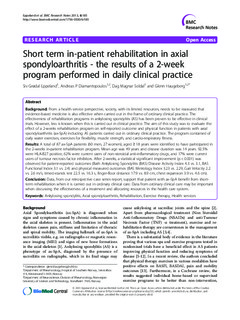| dc.contributor.author | Eppeland, Siv Grødal | |
| dc.contributor.author | Diamantopoulos, Andreas P | |
| dc.contributor.author | Soldal, Dag Magnar | |
| dc.contributor.author | Haugeberg, Glenn | |
| dc.date.accessioned | 2019-10-28T07:57:25Z | |
| dc.date.available | 2019-10-28T07:57:25Z | |
| dc.date.created | 2014-02-20T15:19:09Z | |
| dc.date.issued | 2013 | |
| dc.identifier.citation | BMC Research Notes. 2013, 6 . | nb_NO |
| dc.identifier.issn | 1756-0500 | |
| dc.identifier.uri | http://hdl.handle.net/11250/2624758 | |
| dc.description.abstract | Background
From a health service perspective, society, with its limited resources, needs to be reassured that evidence-based medicine is also effective when carried out in the frame of ordinary clinical practice. The effectiveness of rehabilitation programs in ankylosing spondylitis (AS) has been proven to be effective in clinical trials. However, less is known when this is carried out in clinical practice. The aim of this study was to evaluate the effect of a 2-weeks rehabilitation program on self-reported outcome and physical function in patients with axial spondyloarthritis (ax-SpA) including AS patients carried out in ordinary clinical practice. The program contained of daily water exercises, exercises for flexibility, muscle strength, and cardio-respiratory fitness.
Results
A total of 87 ax-SpA patients (60 men, 27 women), aged ≥ 18 years were identified to have participated in the 2-weeks in-patient rehabilitation program. Mean age was 49 years and disease duration was 14 years. 92.5% were HLA-B27 positive, 62% were current users of non-steroidal anti-inflammatory drugs, and 17% were current users of tumour necrosis factor inhibitors. After 2-weeks, a statistical significant improvement (p < 0.001) was observed for patient-reported outcomes (Bath Ankylosing Spondylitis (BAS) Disease Activity Index 4.3 vs. 3.1, BAS Functional Index 3.1 vs. 2.4) and physical measured outcomes (BAS Metrology Index 3.23 vs. 2.29, Gait Velocity 2.2 vs. 2.6 m/s, timed-stands test 22.5 vs. 16.3 s, finger-floor distance 17.9 vs. 8.9 cm, chest expansion 3.9 vs. 4.6 cm).
Conclusion
Data, from our retrospective case series report, support that patient with ax-SpA benefit from short-term rehabilitation when it is carried out in ordinary clinical care. Data from ordinary clinical care may be important when discussing the effectiveness of a treatment and allocating resources in the health care system. | nb_NO |
| dc.language.iso | eng | nb_NO |
| dc.publisher | BMC (part of Springer Nature) | nb_NO |
| dc.rights | Navngivelse 4.0 Internasjonal | * |
| dc.rights.uri | http://creativecommons.org/licenses/by/4.0/deed.no | * |
| dc.title | Short term in-patient rehabilitation in axial spondyloarthritis - the results of a 2-week program performed in daily clinical practice | nb_NO |
| dc.type | Journal article | nb_NO |
| dc.type | Peer reviewed | nb_NO |
| dc.description.version | publishedVersion | nb_NO |
| dc.source.pagenumber | 6 | nb_NO |
| dc.source.volume | 6 | nb_NO |
| dc.source.journal | BMC Research Notes | nb_NO |
| dc.identifier.doi | 10.1186/1756-0500-6-185 | |
| dc.identifier.cristin | 1117183 | |
| dc.description.localcode | © 2013 Eppeland et al.; licensee BioMed Central Ltd. This is an Open Access article distributed under the terms of the Creative Commons Attribution License (http://creativecommons.org/licenses/by/2.0), which permits unrestricted use, distribution, and reproduction in any medium, provided the original work is properly cited. | nb_NO |
| cristin.unitcode | 194,65,30,0 | |
| cristin.unitname | Institutt for nevromedisin og bevegelsesvitenskap | |
| cristin.ispublished | true | |
| cristin.fulltext | original | |
| cristin.qualitycode | 1 | |

